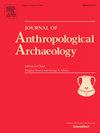Critiquing the logics of prestige in the interpretation of Cycladic Figurines: Towards an archaeological theory of value
IF 2.2
1区 社会学
Q1 ANTHROPOLOGY
引用次数: 0
Abstract
This article applies the concept of enactive signification to the subject of Early Cycladic figurines, critiquing the use of prestige frameworks for the interpretation of these objects and contributing to the archaeological analysis of the semiotics of value. I examine social organisation during the emergence of the Aegean Early Bronze Age and the material sign relations of Grotta-Pelos mortuary practices to argue that the figurines developed through kinshipping practices and gifting dynamics. Grotta-Pelos schematic figurines were small, personal, and mobile objects that emerged during a period in which dispersed communities were highly dependent upon local interaction networks for social reproduction and survival, suggesting that the circulation of these figurines supported a form of distributed intersubjectivity. The schematics were readily sourced, easily shaped, attractive, mobile, and unlikely to inspire particularly competitive interactions, properties that indicate that these marble objects acted as a locus of social value generated through acts of crafting, imitation, gifting, and circulation.
基克拉迪人雕像解释中的声望逻辑批判:走向一种考古价值理论
本文将活动意义的概念应用于早期基克拉迪雕像的主题,批评使用声望框架来解释这些对象,并为价值符号学的考古分析做出贡献。我研究了爱琴海早期青铜器时代出现期间的社会组织,以及格罗塔-佩洛斯太平间习俗的物质符号关系,以证明这些小雕像是通过亲属关系和赠与动态发展起来的。格罗塔-佩洛斯图解雕像是小型的、个人的、可移动的物体,出现在分散的社区高度依赖当地互动网络进行社会繁殖和生存的时期,这表明这些雕像的流通支持了一种分布式的主体间性形式。这些图表来源方便,易于塑造,具有吸引力,可移动,并且不太可能激发特别的竞争互动,这些属性表明这些大理石物品通过制作,模仿,赠送和流通行为产生了社会价值。
本文章由计算机程序翻译,如有差异,请以英文原文为准。
求助全文
约1分钟内获得全文
求助全文
来源期刊

Journal of Anthropological Archaeology
Multiple-
CiteScore
4.00
自引率
11.10%
发文量
64
期刊介绍:
An innovative, international publication, the Journal of Anthropological Archaeology is devoted to the development of theory and, in a broad sense, methodology for the systematic and rigorous understanding of the organization, operation, and evolution of human societies. The discipline served by the journal is characterized by its goals and approach, not by geographical or temporal bounds. The data utilized or treated range from the earliest archaeological evidence for the emergence of human culture to historically documented societies and the contemporary observations of the ethnographer, ethnoarchaeologist, sociologist, or geographer. These subjects appear in the journal as examples of cultural organization, operation, and evolution, not as specific historical phenomena.
 求助内容:
求助内容: 应助结果提醒方式:
应助结果提醒方式:


